Abstract
OBJECTIVE--To evaluate the relations between environmental benzene concentrations and various biomarkers of exposure to benzene. METHODS--Analyses were carried out on environmental air, unmetabolised benzene in urine, trans, trans-muconic acid (ttMA), and three major phenolic metabolites of benzene; catechol, hydroquinone, and phenol, in two field studies on 64 workers exposed to benzene concentrations from 0.12 to 68 ppm, the time weighted average (TWA). Forty nonexposed subjects were also investigated. RESULTS--Among the five urinary biomarkers studied, ttMA correlated best with environmental benzene concentration (correlation coefficient, r = 0.87). When urinary phenolic metabolites were compared with environmental benzene, hydroquinone correlated best with benzene in air. No correlation was found between unmetabolised benzene in urine and environmental benzene concentrations. The correlation coefficients for environmental benzene and end of shift catechol, hydroquinone, and phenol were 0.30, 0.70, and 0.66, respectively. Detailed analysis, however, suggests that urinary phenol was not a specific biomarker for exposure below 5 ppm. In contrast, ttMA and hydroquinone seemed to be specific and sensitive even at concentrations of below 1 ppm. Although unmetabolised benzene in urine showed good correlation with atmospheric benzene (r = 0.50, P < 0.05), data were insufficient to suggest that it is a useful biomarker for exposure to low concentrations of benzene. The results from the present study also showed that both ttMA and hydroquinone were able to differentiate the background level found in subjects not occupationally exposed and those exposed to less than 1 ppm of benzene. This suggests that these two biomarkers are useful indices for monitoring low concentrations of benzene. Furthermore, these two metabolites are known to be involved in bone marrow leukaemogenesis, their applications in biological monitoring could thus be important in risk assessment. CONCLUSION--The good correlations between ttMA, hydroquinone, and atmospheric benzene, even at concentrations of less than 1 ppm, suggest that they are sensitive and specific biomarkers for benzene exposure.
Full text
PDF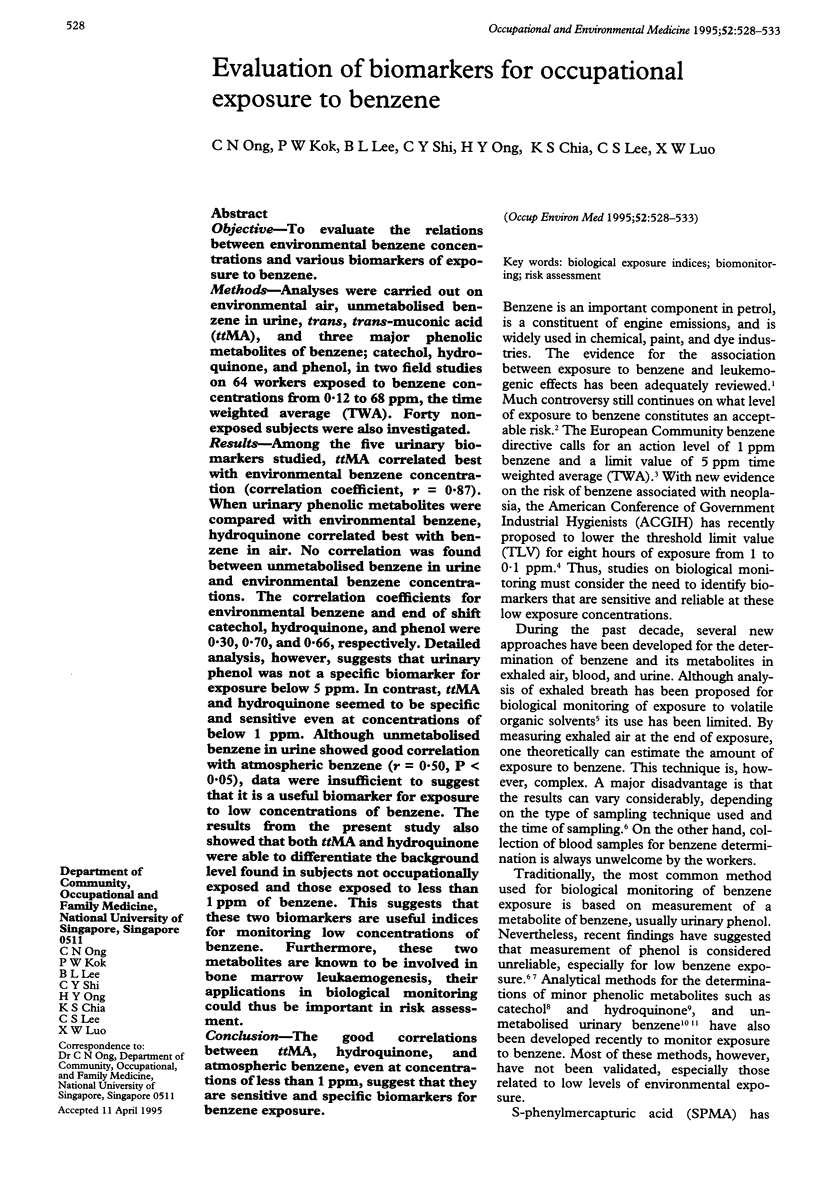
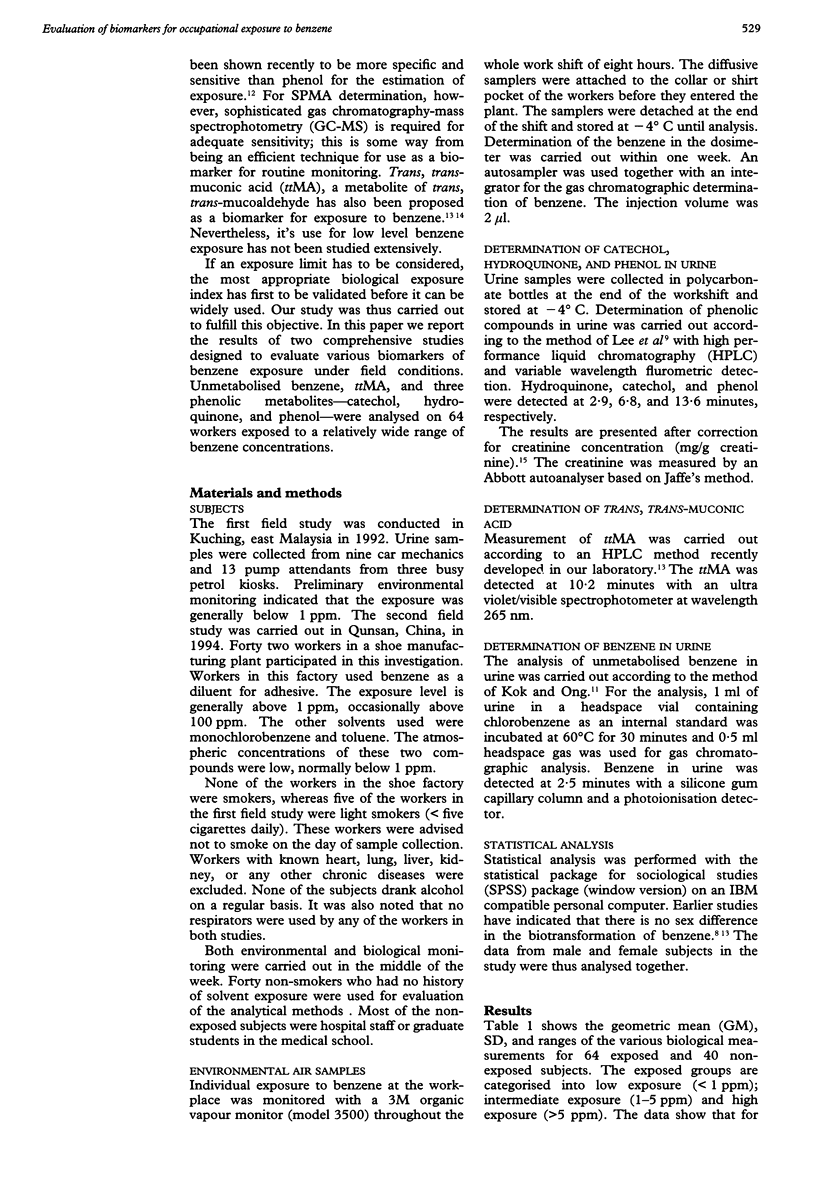
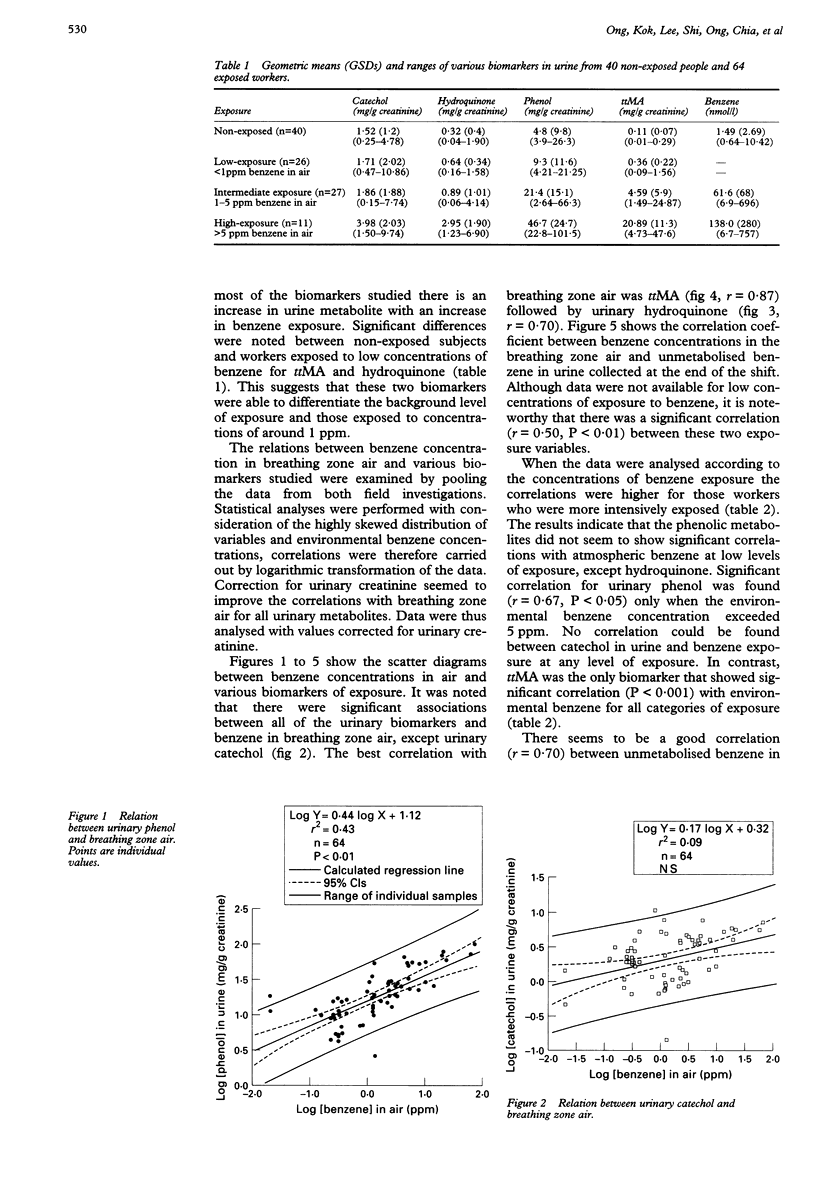
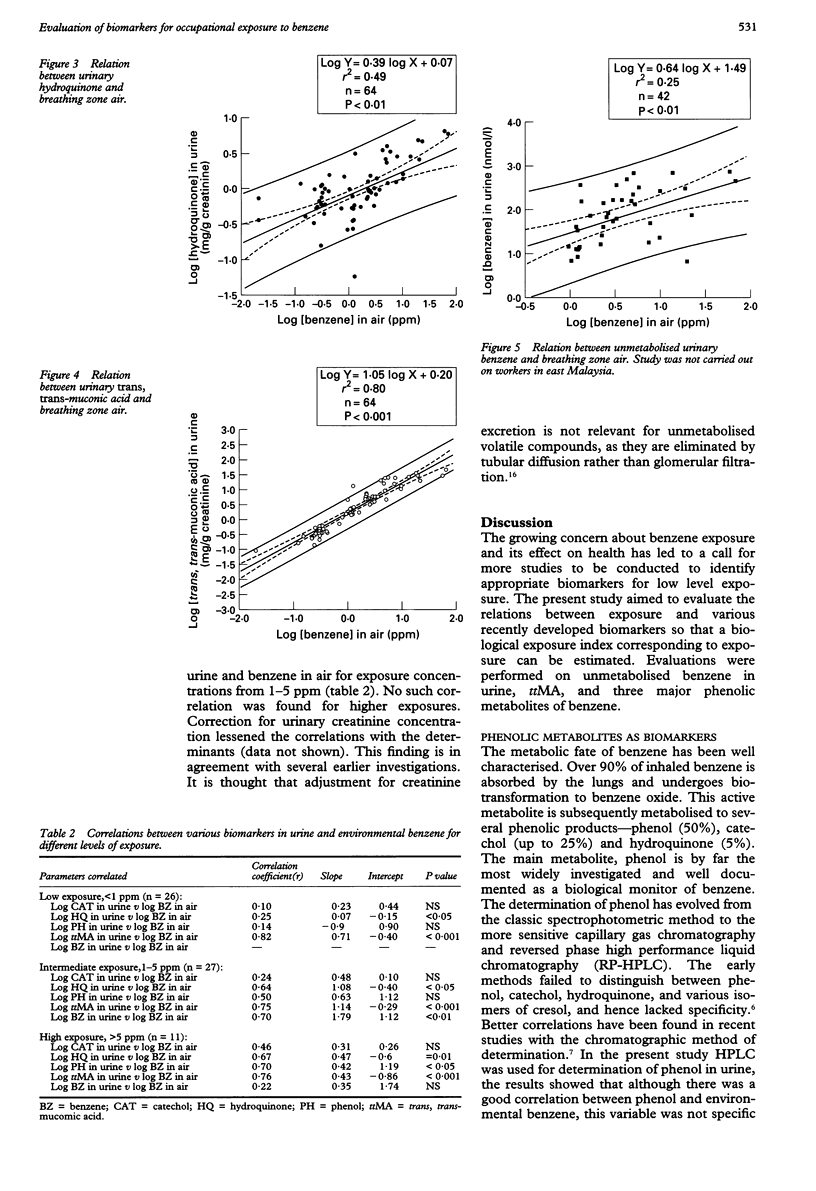
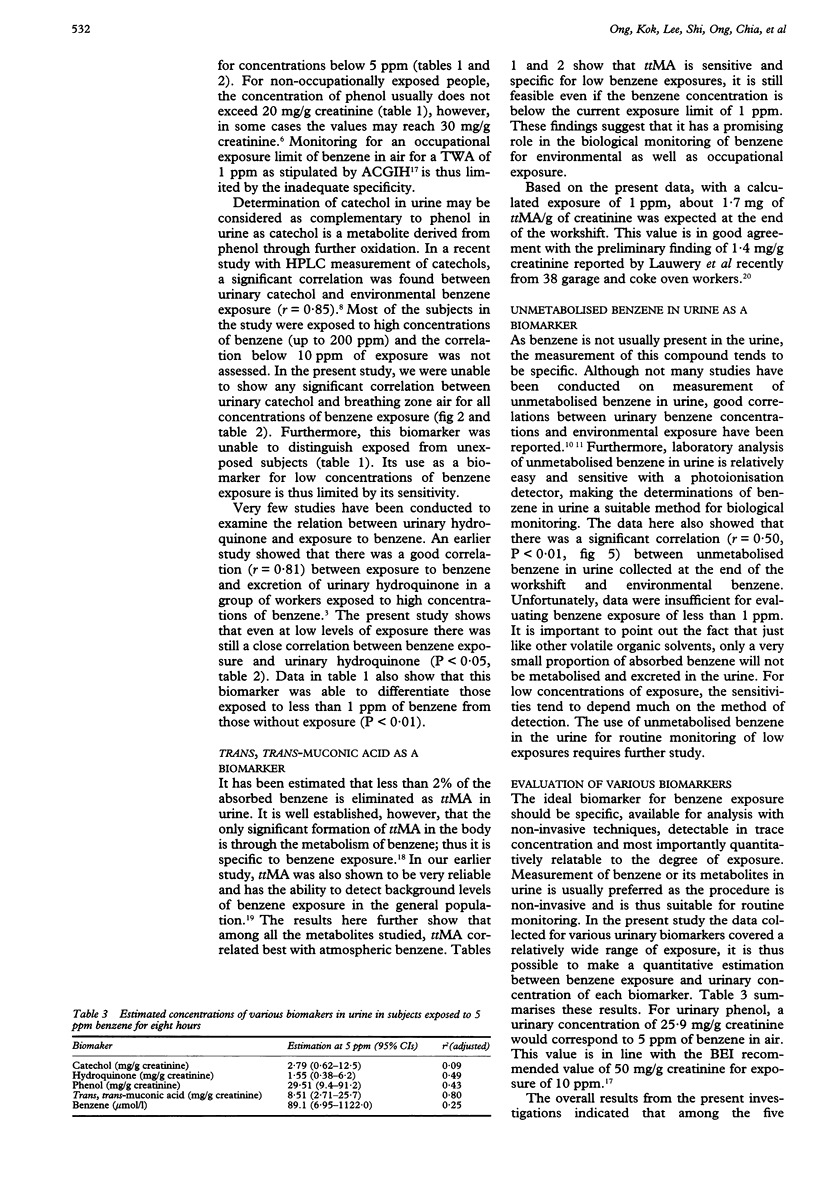
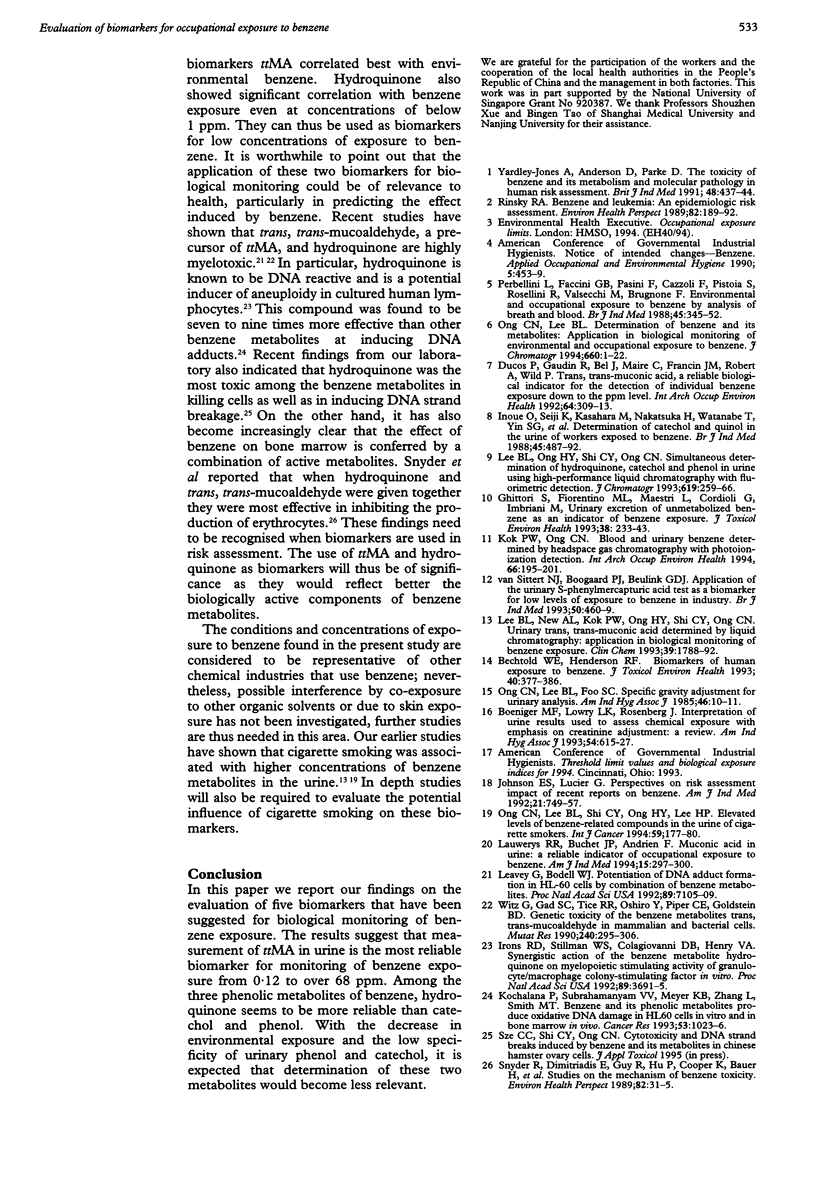
Selected References
These references are in PubMed. This may not be the complete list of references from this article.
- Bechtold W. E., Henderson R. F. Biomarkers of human exposure to benzene. J Toxicol Environ Health. 1993 Oct-Nov;40(2-3):377–386. doi: 10.1080/15287399309531803. [DOI] [PubMed] [Google Scholar]
- Boeniger M. F., Lowry L. K., Rosenberg J. Interpretation of urine results used to assess chemical exposure with emphasis on creatinine adjustments: a review. Am Ind Hyg Assoc J. 1993 Oct;54(10):615–627. doi: 10.1080/15298669391355134. [DOI] [PubMed] [Google Scholar]
- Ducos P., Gaudin R., Bel J., Maire C., Francin J. M., Robert A., Wild P. trans,trans-Muconic acid, a reliable biological indicator for the detection of individual benzene exposure down to the ppm level. Int Arch Occup Environ Health. 1992;64(5):309–313. doi: 10.1007/BF00379538. [DOI] [PubMed] [Google Scholar]
- Ghittori S., Fiorentino M. L., Maestri L., Cordioli G., Imbriani M. Urinary excretion of unmetabolized benzene as an indicator of benzene exposure. J Toxicol Environ Health. 1993 Mar;38(3):233–243. doi: 10.1080/15287399309531715. [DOI] [PubMed] [Google Scholar]
- Inoue O., Seiji K., Kasahara M., Nakatsuka H., Watanabe T., Yin S. G., Li G. L., Cai S. X., Jin C., Ikeda M. Determination of catechol and quinol in the urine of workers exposed to benzene. Br J Ind Med. 1988 Jul;45(7):487–492. doi: 10.1136/oem.45.7.487. [DOI] [PMC free article] [PubMed] [Google Scholar]
- Irons R. D., Stillman W. S., Colagiovanni D. B., Henry V. A. Synergistic action of the benzene metabolite hydroquinone on myelopoietic stimulating activity of granulocyte/macrophage colony-stimulating factor in vitro. Proc Natl Acad Sci U S A. 1992 May 1;89(9):3691–3695. doi: 10.1073/pnas.89.9.3691. [DOI] [PMC free article] [PubMed] [Google Scholar]
- Johnson E. S., Lucier G. Perspectives on risk assessment impact of recent reports on benzene. Am J Ind Med. 1992;21(5):749–757. doi: 10.1002/ajim.4700210513. [DOI] [PubMed] [Google Scholar]
- Kok P. W., Ong C. N. Blood and urinary benzene determined by headspace gas chromatography with photoionization detection: application in biological monitoring of low-level nonoccupational exposure. Int Arch Occup Environ Health. 1994;66(3):195–201. doi: 10.1007/BF00380780. [DOI] [PubMed] [Google Scholar]
- Kolachana P., Subrahmanyam V. V., Meyer K. B., Zhang L., Smith M. T. Benzene and its phenolic metabolites produce oxidative DNA damage in HL60 cells in vitro and in the bone marrow in vivo. Cancer Res. 1993 Mar 1;53(5):1023–1026. [PubMed] [Google Scholar]
- Lauwerys R. R., Buchet J. P., Andrien F. Muconic acid in urine: a reliable indicator of occupational exposure to benzene. Am J Ind Med. 1994 Feb;25(2):297–300. doi: 10.1002/ajim.4700250216. [DOI] [PubMed] [Google Scholar]
- Lee B. L., New A. L., Kok P. W., Ong H. Y., Shi C. Y., Ong C. N. Urinary trans,trans-muconic acid determined by liquid chromatography: application in biological monitoring of benzene exposure. Clin Chem. 1993 Sep;39(9):1788–1792. [PubMed] [Google Scholar]
- Lee B. L., Ong H. Y., Shi C. Y., Ong C. N. Simultaneous determination of hydroquinone, catechol and phenol in urine using high-performance liquid chromatography with fluorimetric detection. J Chromatogr. 1993 Sep 22;619(2):259–266. doi: 10.1016/0378-4347(93)80115-k. [DOI] [PubMed] [Google Scholar]
- Lévay G., Bodell W. J. Potentiation of DNA adduct formation in HL-60 cells by combinations of benzene metabolites. Proc Natl Acad Sci U S A. 1992 Aug 1;89(15):7105–7109. doi: 10.1073/pnas.89.15.7105. [DOI] [PMC free article] [PubMed] [Google Scholar]
- Ong C. N., Lee B. L. Determination of benzene and its metabolites: application in biological monitoring of environmental and occupational exposure to benzene. J Chromatogr B Biomed Appl. 1994 Oct 3;660(1):1–22. doi: 10.1016/0378-4347(94)00278-9. [DOI] [PubMed] [Google Scholar]
- Ong C. N., Lee B. L., Shi C. Y., Ong H. Y., Lee H. P. Elevated levels of benzene-related compounds in the urine of cigarette smokers. Int J Cancer. 1994 Oct 15;59(2):177–180. doi: 10.1002/ijc.2910590206. [DOI] [PubMed] [Google Scholar]
- Perbellini L., Faccini G. B., Pasini F., Cazzoli F., Pistoia S., Rosellini R., Valsecchi M., Brugnone F. Environmental and occupational exposure to benzene by analysis of breath and blood. Br J Ind Med. 1988 May;45(5):345–352. doi: 10.1136/oem.45.5.345. [DOI] [PMC free article] [PubMed] [Google Scholar]
- Rinsky R. A. Benzene and leukemia: an epidemiologic risk assessment. Environ Health Perspect. 1989 Jul;82:189–191. doi: 10.1289/ehp.8982189. [DOI] [PMC free article] [PubMed] [Google Scholar]
- Snyder R., Dimitriadis E., Guy R., Hu P., Cooper K., Bauer H., Witz G., Goldstein B. D. Studies on the mechanism of benzene toxicity. Environ Health Perspect. 1989 Jul;82:31–35. doi: 10.1289/ehp.898231. [DOI] [PMC free article] [PubMed] [Google Scholar]
- Witz G., Gad S. C., Tice R. R., Oshiro Y., Piper C. E., Goldstein B. D. Genetic toxicity of the benzene metabolite trans, trans-muconaldehyde in mammalian and bacterial cells. Mutat Res. 1990 Apr;240(4):295–306. doi: 10.1016/0165-1218(90)90080-l. [DOI] [PubMed] [Google Scholar]
- Yardley-Jones A., Anderson D., Parke D. V. The toxicity of benzene and its metabolism and molecular pathology in human risk assessment. Br J Ind Med. 1991 Jul;48(7):437–444. doi: 10.1136/oem.48.7.437. [DOI] [PMC free article] [PubMed] [Google Scholar]
- van Sittert N. J., Boogaard P. J., Beulink G. D. Application of the urinary S-phenylmercapturic acid test as a biomarker for low levels of exposure to benzene in industry. Br J Ind Med. 1993 May;50(5):460–469. doi: 10.1136/oem.50.5.460. [DOI] [PMC free article] [PubMed] [Google Scholar]


